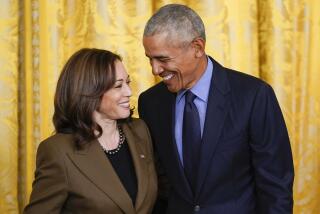Bill Clinton in ‘08!
It is one of the ironies of the 2008 campaign that probably the most popular Democrat and the most electable Republican are both ineligible to run for the presidency. The 22nd Amendment bars Bill Clinton from a third election to the office of president, while the original Constitution renders Arnold Schwarzenegger ineligible for the presidency because he is a naturalized rather than a “natural-born” citizen.
But what about the second position on the national tickets? Could the Republicans and Democrats avail themselves of the charisma and experience of these two leaders by nominating them for the vicepresidency? (Please e-mail your clever double-entendres to the address below.)
FOR THE RECORD:
Vice president: In an opinion piece Tuesday about who can run for vice president of the United States, the constitutional amendment establishing two-term presidencies was incorrectly identified, on second reference, as the 24th Amendment. It is the 22nd Amendment.
Let’s start with Gov. Schwarzenegger. Fearful of foreign influence over the new nation, the framers of the Constitution included in Article II, Section 1 the directive that “no person except a natural born Citizen ... shall be eligible to the Office of President.” They said nothing about the citizenship of the vice president. Thus, under the original Constitution, Schwarzenegger could have been elected vice president, but he could not have ascended to the top job on the death or removal of the president.
This anomaly was but part of the framers’ incomplete explication of the vice presidency -- a failing that has manifested itself in a variety of forms, from John Adams’ lament that the Constitution created “the most insignificant office that ever the invention of man contrived” to Dick Cheney’s assertion that he occupies an office that stands apart from the three branches of U.S. government. The best explanation of the framers’ failure to state qualifications for the vice president lies in the election process they devised: The candidate with the most votes in the electoral college would be president and, “after the choice of the President, the Person having the greatest Number of votes of the Electors shall be Vice-President.” In other words, the framers assumed anyone elected vice president would meet the qualifications for the presidency because he would have run as a candidate for that office.
The framers’ incorrect electoral assumption was of no consequence in the first two elections, in which George Washington became president by acclamation and John Adams (competing against a variety of other candidates) was elected vice president. Then, with Washington’s retirement and the rise of national political parties, chaos ensued.
In 1796, Adams (who had won the popular vote) received 71 votes in the electoral college and was elected president. Thomas Jefferson, Adams’ opponent, received 68 votes and therefore became vice president. Adams had a running mate, Thomas Pinckney, who received only 59 electoral votes.
Then, in 1800, Jefferson and his running mate, Aaron Burr, won the popular vote and defeated Adams and his vice presidential candidate in the electoral college. But the electors failed to cast their ballots separately for Jefferson and Burr, with the result that both had an equal number of electoral votes. That threw the election into the House of Representatives, which elected Jefferson to the presidency on the 36th ballot after Jefferson’s archrival, Alexander Hamilton, pronounced Jefferson “by far not so dangerous a man” as Burr.
The 12th Amendment, proposed to avoid such debacles, was ratified in 1804. It requires the electoral college to cast “distinct ballots” for president and vice president. And, recognizing that candidates would run expressly for the vice presidency, it included a statement of qualifications: “No person constitutionally ineligible to the office of President shall be eligible to that of Vice-President of the United States.”
Alas, poor Arnold, and woe to the Republicans. If they wanted a big-state vice presidential candidate with business and environmental street cred, who appeals to independent voters and Democrats, forget about it. Michael Bloomberg is no longer one of yours.
But what of the Democrats and Bill Clinton? The 24th Amendment, adopted in reaction to Franklin Roosevelt’s 1944 election to a fourth term, declares that “no person shall be elected to the office of the President more than twice.” Although it was not the focus of the amendment, it is notable that the amendment does not preclude a former two-term president (such as Clinton) from serving as vice president. Nor does it preclude a former two-term president’s succession to the presidency for all or part of a third term.
It might seem that the 12th Amendment’s dictum that “no person constitutionally ineligible to the office of President shall be eligible to that of Vice-President” also ought to doom Clinton’s chances -- but no again: He is ineligible for election to a third term, but he is constitutionally eligible to succeed to the presidency after election to the vice presidency.
There is, however, one last constitutional wrinkle. The 12th Amendment declares that the members of the electoral college “shall meet in their respective states, and vote by ballot for President and Vice-President, one of whom, at least, shall not be an inhabitant of the same state with themselves.” This effectively prevents the president and vice president from having the same state residency, because if running mates shared a home state, the electors from that state would be unable to vote for both of them. Thus, unless the former president returns to Arkansas, “Hill-Bill” or Clinton2 is out.
That leaves only one alternative. You heard it here first, Democrats: Obama-(Bill) Clinton 2008!
Brian E. Gray is a professor at UC Hastings College of Law.
grayb@uchastings.eduMore to Read
Get the L.A. Times Politics newsletter
Deeply reported insights into legislation, politics and policy from Sacramento, Washington and beyond. In your inbox three times per week.
You may occasionally receive promotional content from the Los Angeles Times.










